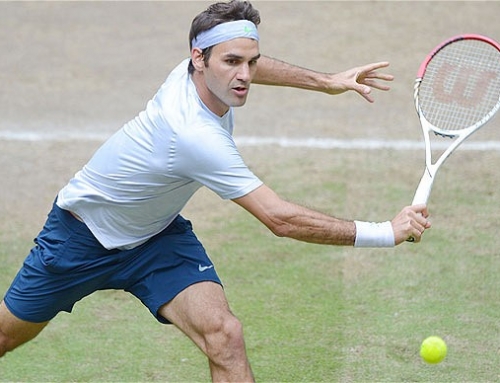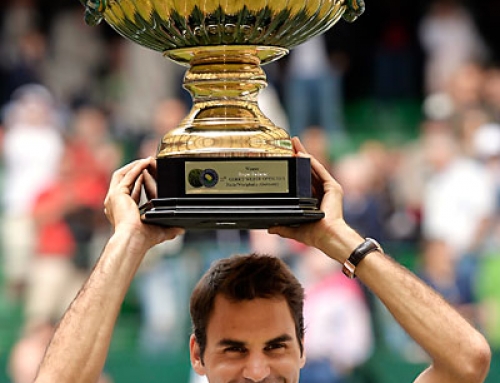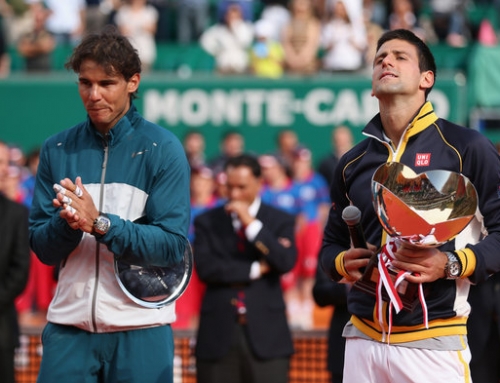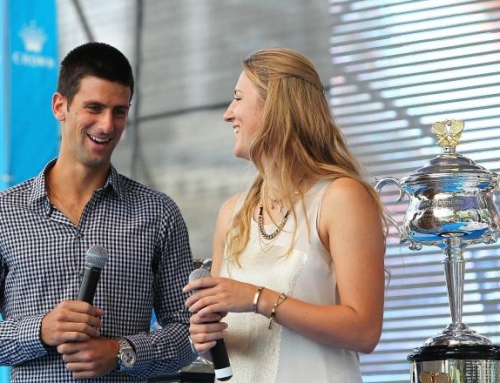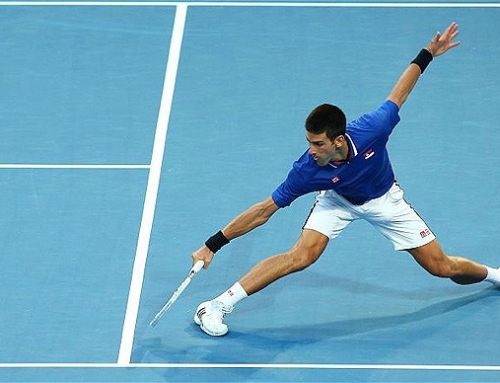 At the end of November during the conclusion of the year-end championship at London, Roger Federer hoisted the trophy once again. This meant a lot to Roger. He had not won a Slam all year. He was defending a large number of points from his successful foray at the end of the previous year. Andy Murray had built a large number of points during the Asian swing where he won three tournaments in a row and was threatening to end the year at number 3, a goal he openly talked about after the US Open. Federer really pulled a rabbit out of the hat doing better than he had in the previous year, at least in the weeks leading to London.
At the end of November during the conclusion of the year-end championship at London, Roger Federer hoisted the trophy once again. This meant a lot to Roger. He had not won a Slam all year. He was defending a large number of points from his successful foray at the end of the previous year. Andy Murray had built a large number of points during the Asian swing where he won three tournaments in a row and was threatening to end the year at number 3, a goal he openly talked about after the US Open. Federer really pulled a rabbit out of the hat doing better than he had in the previous year, at least in the weeks leading to London.
In 2010, Federer was a runnerup in Shanghai, then won Stockholm and Basel, was a semifinalist in Paris, then won London. Federer played five tournaments, won 3, runner up in another, and semifinalist in the other. This should have given him a little over 3000 points all put together.
In 2011, Federer felt like he needed more recovery time. He withdrew from Shanghai and gave himself 5 weeks of rest. He won Basel, Paris, and London and picked up 3000 ATP points comparable to what he did the previous year, but with two fewer tournaments entered.
Despite this success, there were a bunch of caveats. Andy Murray, the one player who was mostly in form, ran into two injuries that bothered him at the worst possible moments. In Basel, which Murray entered at the last minute, Murray suffered from a buttock injury in the middle of the night. This forced him to withdraw without playing a single match. A few days later, Murray was back in action and playing in Paris, but an in-form Berdych knocked him out of the quarterfinals. Then, perhaps in a spate of over training, Murray again injured himself right before London. He played one match, which he lost to Ferrer, and then withdrew from London.
Again, this injury was nothing too serious. After a few weeks rest, Murray was back in training.
Novak Djokovic, like Roger Federer, also skipped 5 weeks and did not play Shanghai. His plan was to play Basel, Paris, and London. Although his back issues improved with the rest, his shoulder issues seemed to plague him. Djokovic reached the semis of Basel where he was upset by Kei Nishikori, though mostly because Djokovic wasn’t 100%. Then, in Paris, he had to retire after beating Troicki leading Tsonga to a finals berth against Federer (Federer won).
Finally, in London, Djokovic barely on his first round robin match, saving match points, and beating Tomas Berdych. Djokovic lost to Ferrer and Tipsarevic showing he was still a bit off-form. Djokovic decided to only enter in the Abu Dhabi tournament as preparation for Australia. He arrived more than a week ahead of time. Due to Federer and Nadal committing earlier, they had been promised the two byes that normally go to the top seeds. Djokovic didn’t have a problem with this as he got one more match to prep. He beat Monfils in the opening round, then easily handled Federer, then beat Ferrer (who had upset Nadal in the semis) just as easily. Although it was an exhibition, Djokovic seemed to be back to normal as he had claimed earlier on. The question is how he’ll handle five setters in the heat. Djokovic has headed to Melbourne early as well.
Rafael Nadal ended 2011 without a win. He lost in the finals of the US Open in a marathon match that seemed to take the energy out of both players. Nadal fared the better of the two. He returned back to Spain and helped win the Davis Cup with wins over Monaco and del Potro. Nadal played Tokyo where he was defending champ, but lost to a highly in-form Murray in three sets. Nadal then continued the doldrums of play and lost to Florian Mayer in Shanghai. Mayer did not drop serve that match, and Nadal struggled to explain why he didn’t play better.
Nadal skipped Paris as he did the previous year. His motivation didn’t seem to return at London. Nadal struggled to beat Fish and needed a third set tiebreak and a nervous Fish to win. Nadal was then thumped by Federer in the second round robin match. Finally, Nadal lost to Tsonga in three sets and failed to qualify for the semifinals once again. Nadal did return back to form in Spain for the Davis Cup, but his motivation was being questioned.
Nadal played the Abu Dhabi exhibition. Prior to this, he said he planned to take some number of weeks of after the Australian Open. Normally, Nadal plays a tournament like Rotterdam then plays once again at Indian Wells. Nadal plans to wait until Indian Wells to play again. In Abu Dhabi, Nadal lost to countryman, David Ferrer. He felt he wasn’t quite ready to play. He said he had to take some time off to recover and hadn’t trained as much as he normally does, so he didn’t expect to beat Ferrer.
In Doha, Nadal was playing better, but lost to Monfils who has been trying to redo his game. In particular, Monfils is trying to come to net more often and hit bigger shots. Monfils combination of defense and offense proved too much for Nadal and Nadal lost in the semis of Doha.
Despite Federer’s success at the end of 2011, he didn’t come roaring out of the gates in 2011. Like Nadal, Federer said he needed some rest and felt like he wasn’t able to add much more to his game during the December break. He said he was in maintenance mode trying to keep his game where it was at the end of 2011. Federer was crushed by Djokovic in Abu Dhabi. Federer would probably claim that it’s only an exhibition, that he was trying a few things, and that the Australian Open was more important. All true, and all excuses he’s used in previous years when he loses in Abu Dhabi.
Federer also had to withdraw from only his second tournament ever in Doha. After a touch-and-go win over Andreas Seppi in the quarterfinals, Federer withdrew from Doha in the semis. He claimed a back spasm that flared in the Seppi match caused him to take the precaution of dropping out. Federer assured the media that a few days rest, and he would be ready to play in Melbourne.
That leaves Andy Murray. Murray felt, post-US Open, that he was in the best form in a while. He won Bangkok, a tournament he was originally reluctant to go to because of niggling injuries, but he won that, then Tokyo, then Shanghai. He didn’t play any top tier players save Nadal in the finals of Tokyo, perhaps his best match of the stretch. Murray had hoped that he could pull ahead of Federer with a solid performance in either Basel or Paris. Unfortunately, Murray withdrew from Basel, lost in the quarters of Paris, then only played one round robin match in London before withdrawing.
Murray opted, in 2012, to play Brisbane. In previous years, he had played Doha, but complained about how cold Doha was in comparison with Australia. He then played the Hopman Cup the last two years. This year, he decided to play Brisbane in Australia. Initially, this almost seemed like a mistake because he struggled in his first two rounds losing the opening set before winning in three sets. However, he didn’t drop a set in victories over Baghdatis, Tomic, and Dolgopolov. Murray also announced, prior to the tournament, that he and Ivan Lendl were going to work together.
Most experts agreed the choice was a savvy one, but realized that Lendl’s effects would probably not be immediately felt. Lendl had done some homework by reviewing matches that Murray played last year to get a feel for what Murray’s game was like. Lendl arrived in Brisbane the day before the semifinals, so he was able to watch the Tomic and Dolgopolov match. Murray is planning to play an exhibition match against David Nalbandian prior to the start of the Australian Open. He also played doubles in Brisbane to get ready.
So where does this leave us?
Djokovic
Djokovic played very well in Abu Dhabi excluding the three-set win over Monfils. Djokovic claimed the issues that were bothering him in London were behind him. However, he hasn’t played an official tournament since London. Still, if he’s in the form he says, he should still be expected to go deep in Melbourne. The one gotcha is the weather. Last year, Melbourne was not exceptionally hot. This helped Djokovic. Djokovic also got a reprieve. Against Troicki, Djokovic only played a set before Troicki retired, so he effectively won one fewer match than everyone else.
Thus, the big question for Djokovic is whether he’s back to the level that won him this title a year ago. The feeling is yes, he is, but that doesn’t mean he’ll win.
Rafael Nadal
Much like last year, the big question for Nadal is motivation. Nadal lost six times in a row to Djokovic, all in finals: Indian Wells, Miami, Madrid, Rome, Wimbledon, US Open. Nadal seemed to struggle against Djokovic despite having opportunities to win. Nadal had plenty of chances against Djokovic in Indian Wells and then had a third set tiebreak in Miami. With those losses, Djokovic gained confidence and Nadal struggled losing to Djokovic twice on clay for the first time ever.
Some of this may be players finally getting used to how Nadal plays combined with Nadal occasionally making errant shots.
Nadal also said that he needed recovery time, so was unable to practice as much as he’d like. He also announced he planned to take a few weeks off after the Australian Open. This suggests Nadal is not 100%. Nadal has historically struggled at the Australian Open. Last year, he had an injury and lost to Ferrer. The year before, he lost to Murray in the quarterfinals. He did win the title one year, back in 2009, but that’s the only final Nadal has reached.
Roger Federer
Federer ended 2011 on a high so it was natural for pundits to claim he was ready to win a Slam. But then he got crushed in Abu Dhabi by Djokovic and more disturbingly, had to withdraw from Doha with a back injury, only the second time Federer has ever withdrawn from a tournament in his career.
In Federer’s three tournament wins, he played only one top player, and that was Nadal in the round robins. He didn’t play either Murray, who would have been in reasonable form, nor did he play Djokovic, who was out of sorts.
The question is whether this injury is minor, like what Murray had last year, or is something that will give him problems.
Rest of the field
It’s not as if the rest of the field isn’t dangerous. The Doha finalists were Tsonga and Monfils. Tsonga continues to show he’s a threat to move higher in the rankings. Monfils is trying to be more aggressive after years of being told to be more aggressive. Tomas Berdych played very well in the Hopman Cup helping the Czech Republic win the title despite its exhibition status.
In addition, Janko Tipsarevic reached the finals of Chennai once again, but lost to Milos Raonic. Raonic had a breakout tournament last year in Melbourne and may be in position to go deep again. Bernard Tomic reached the semis of Melbourne with his unorthodox playing style. Can he go deep in his home tournament? And let’s not forget Juan Martin del Potro, who is still aiming to break the top ten once again.
There appear to be more players that have a chance to do well this year at the Australia than in previous years.
So we have questions a-plenty and they’ll get answered in the next two weeks!



